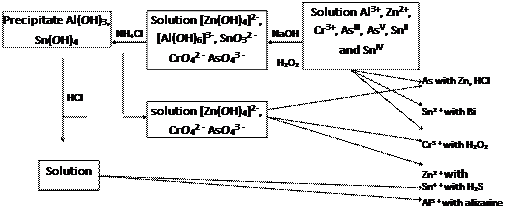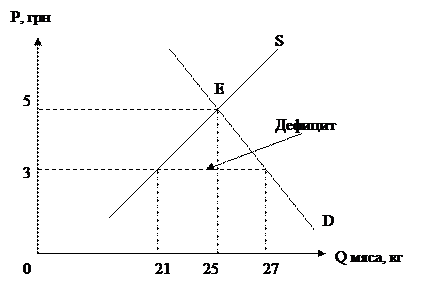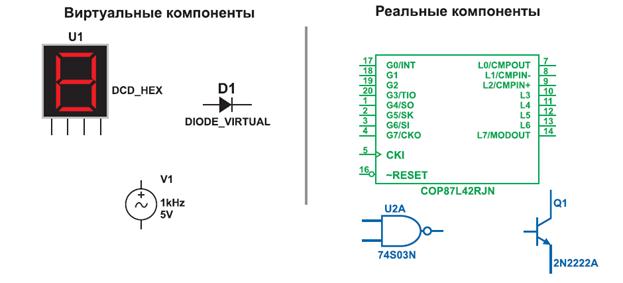ANSWERS TON THE SELF-ASSESSMENT
Al (OH)3, Sn(OН)4 CrО42-, AsО43-, [Zn(OH)4]2- 2.3. Determination of Aluminium and Tin. A precipitate 1 dissolve in 6 mol/L a solution chlorid acid. In the received solution are determinated Al3 + andSn (IV)ions. 2.4. In a solution 2 determinate of ions of Arsene, Zinc and Chrome (in the form of chromat-ions).
Methodical instruction For the students of pharmaceutical faculty LESSON 3 (practical – 6 hours) THEME: Fourth group of cations. Buffer Solutions. AIM: to learn characteristic reactions of cations of ІV analytical group. To learn theory of buffer action, the mechanism of action, property of buffer solutions. To learn to calculate рН of buffer solutions and change рН when to add acids, the bases. PROFESSIONAL MOTIVATION OF STUDENTS In IV analytical group cations on the acid-base classification are ions Al3+, Zn2+, Cr3+, AsIII, AsV, SnII, SnIV. Compounds with Al, Zn, As are applied as drugs; compounds of Al, Cr, As, Sn are used in the pharmaceutical analysis. Therefore the future pharmacist should own knowledge of chemical-analytical properties of the given group of ions. PROGRAM OF SELF-PREPARATION 1. The common and characteristic reactions of cations of IV analytical group. 2. The systematic analysis of a cations mix of IV analytical group. 3. The systematic analysis of a cations mix of I-IV analytical groups. 4. Buffersolutions: theory, types, the mechanism of action, properties, calculation of рН. TESTS AND REAL-LIFE SITUATIONS FOR SELF-ASSESSMENT 1. The common reaction of detection of As compounds is reaction: A. with silver nitrate. B. with ammonium molibdate. C. with iodine. D. with potassium iodide. E. reducing to arsyne. 2. Preliminary tests by using of specific reactions it is possible to detection following ions of IV analytical group: A. As (III), Al3+, Cr3+. B. As (III), As (V). С. Sn (II), Sn (IV), Al3+, Cr3+. D. As (III), As (V), Sn (II), Sn (IV), Zn2+, Al3+, Cr3 +. E. AsО33-, AsО43-, Sn (II), Sn (IV), Al3 +, Cr3 +. 3. After adding to IV analytical group of cations group reagent NaOH + H2O2, add ammonium chloride. Then precipitates from: A. Zn(OH)2, Al(OH)3. B. Al(OH)3, Cr(OH)3. С. Sn(OH)2, Sn(OH)4. D. Zn(OH)2, Cr(OH)3. E. Al(OH)3, Sn(OH)4. 4. Ions of IV analytical group after adding group reagent are in a solution in species of: A. Cations. B. Hydroxicomplex and anions. C. Molecules. D. Anions. E. Precipitates.
1. Calculate рН a buffer solution which consists from 0,1 mol/L solution Sodium acetate and 0,1 mol/L acetic acid. 2. Calculate рН a buffer solution which contains 0,1 mol/L of ammonia and 0,2 mol/L ammonium chloride. 3. Calculate, as will change рН if to 1,0 L of a buffer solution which contains 0,01 mol acetic acid and 0,01 mol Sodium acetate, to add 10-3 mol chloridic acid. 4. Calculate a relationship of molar concentration of acid and the conjugate base in an acetic buffer solution with рН 5,50. 5. Calculate рН a solution received by mixing of 200,0 mL of 0,010 mol/L Sodium phosphate solution and 100,0 mL of 0,02 mol/L of Sodium hydrophosphate solution. Calculate buffer capacity of this solution. 6. Calculate a relationship of molar concentration of ammonium ions and ammonia in an ammoniac buffer solution with рН=9,00.
ANSWERS TON THE SELF-ASSESSMENT Tests:1. Е, 2. Е, 3. Е, 4. B Tasks:1., 2., 3., 4., 5., 6.
REFERENCES: 1. The lecture’s material. 2. David Harvey. Modern Analytical Chemistry // www.mhhe.com
|





